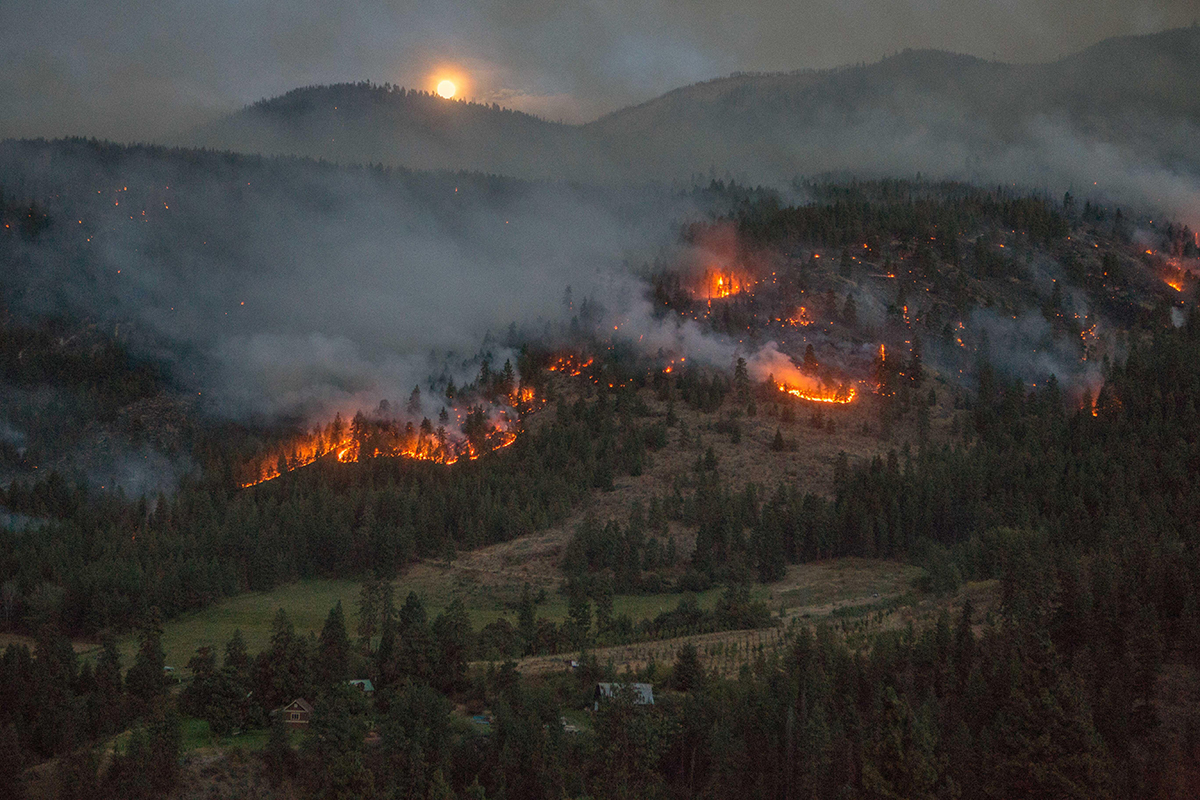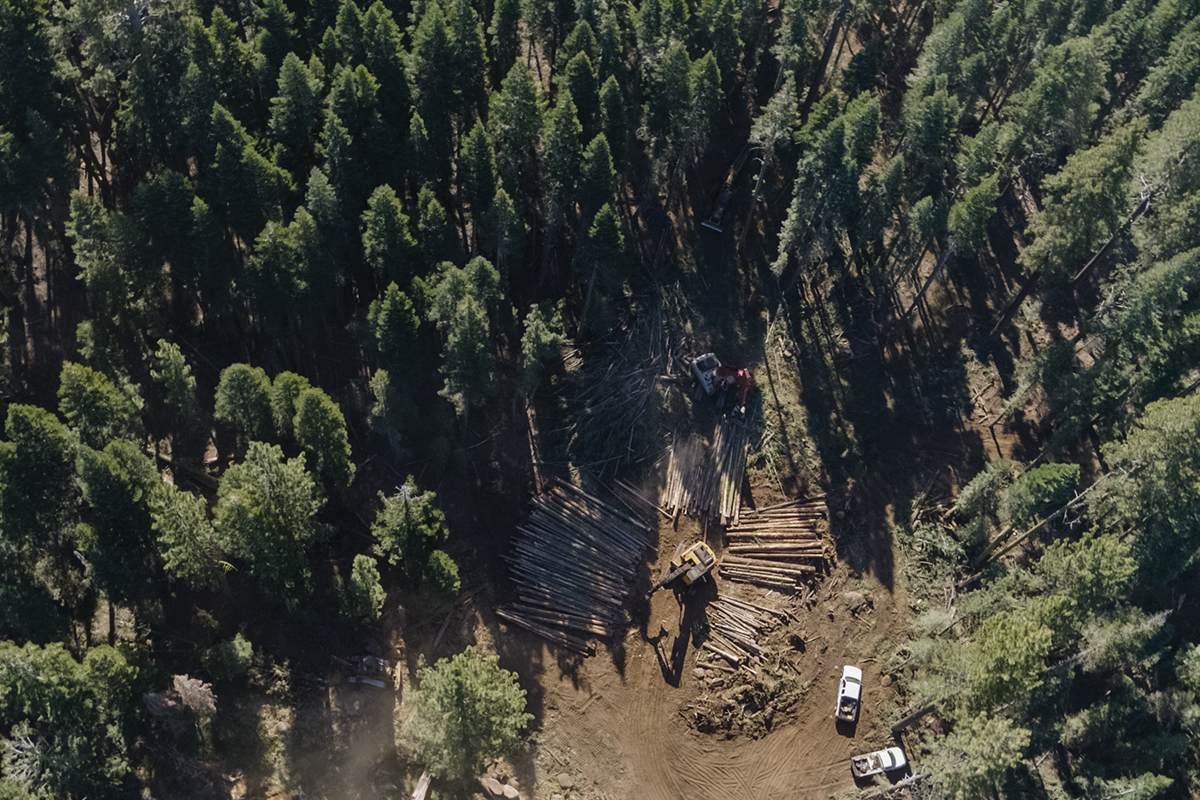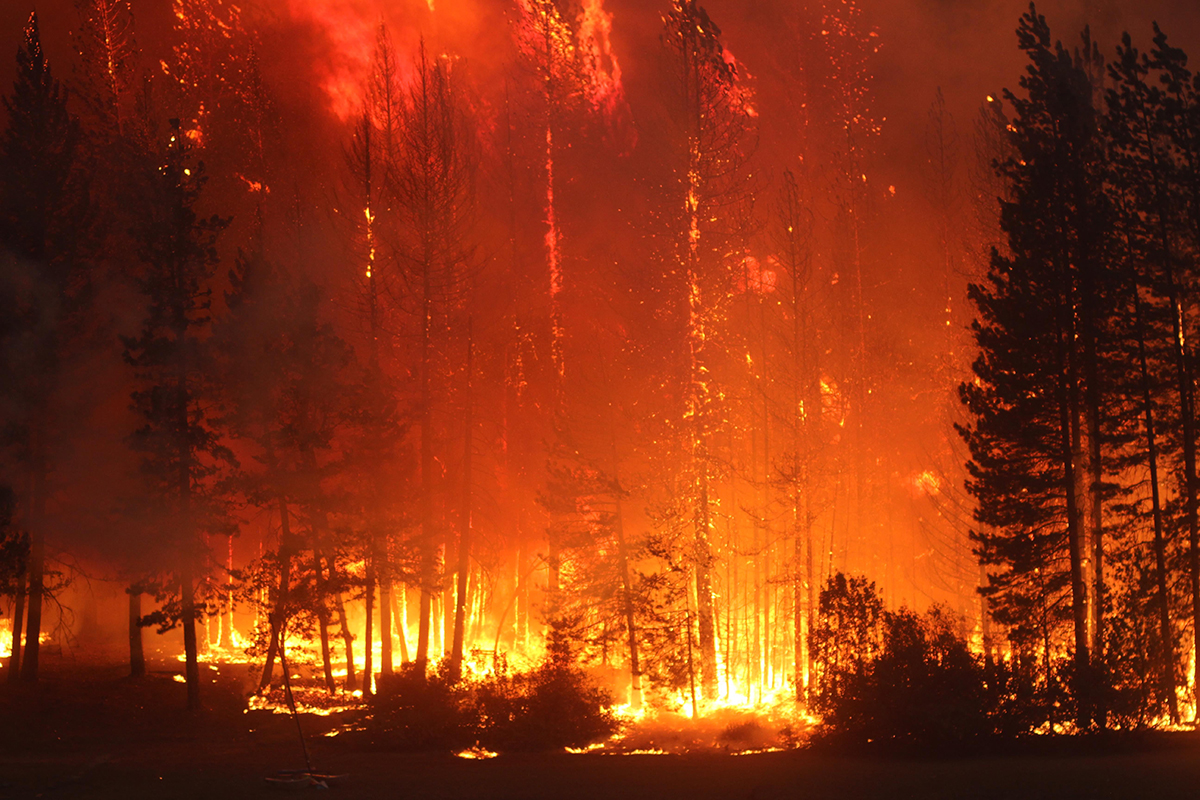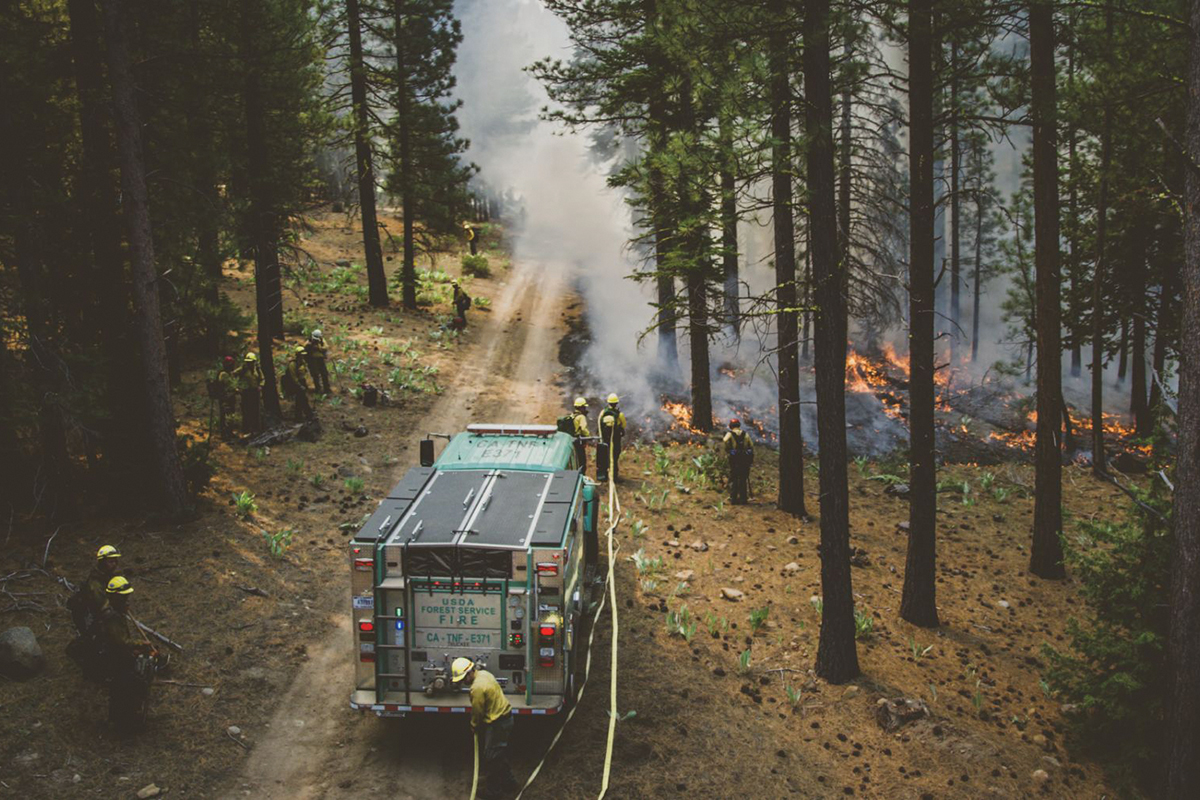In 2020, California experienced the largest wildfire in its history. The August Complex fire burned more than one million acres and laid waste to hundreds of structures. Across the West this year, wildfires have torched 9.5 million acres, destroyed thousands of homes, and caused dozens of fatalities.
As fires have become more intense, the U.S. Forest Service has spent more money fighting them, often at the expense of other programs. Today, the costs of fire suppression have ballooned to roughly half of the Forest Service’s total budget, including more than $3 billion in fire-fighting costs in 2020.
With fire demanding the agency’s attention and resources, forest health has declined. According to the Forest Service, 80 million of the 193 million acres managed by the agency are in need of restoration, which can include mechanical thinning, prescribed burns, erosion control, and replanting. Forest restoration addresses excess fuels, increases resilience to disease and insect infestation, and mitigates the effects of past fires and infestations. Sixty-three million of the acres in need of restoration are at high or very high risk of wildfire.
Addressing the daunting backlog is essential to tackle the wildfire problem. But the Forest Service’s capacity to complete this work is constrained by limited funding, bureaucratic obstacles, and litigation risks. At the Forest Service’s current pace of fuel reduction and forest restoration, it will take decades to work through the backlog.
Fortunately, states, local governments, industry, and conservation groups that benefit from healthier forests have incentives to contribute funding, manpower, and other means of support. Innovative public-private partnerships have demonstrated an ability to increase and expedite needed restoration, while promoting collaboration among diverse interests; however, these innovative solutions are the exception, not the rule.
Expanding public-private partnerships to the extent necessary to address such a large backlog requires greater flexibility for the Forest Service to enter into these partnerships along with fixes to the bureaucratic obstacles, litigation risks, and other barriers that can delay or derail forest restoration projects. Addressing these barriers would allow market forces to facilitate collaborative restoration that increases forest resilience and decreases wildfire risk.
It’s Getting Hot in Here
Fire, both natural and human-induced, can play an important role in maintaining a healthy forest. It can clear underbrush, aid in forest transition, and improve wildlife habitat. But, as we all know, fire can also be devastating. Extreme wildfires destroy habitat, jeopardize water quality, and threaten communities. They are also more difficult for forests to recover from, as hotter fires can damage topsoil, cause erosion, and make revegetation more difficult.
Large wildfires also release significant amounts of carbon dioxide into the atmosphere, converting a forest from a carbon sink into a carbon source. According to scientists at the National Center for Atmospheric Research, “large wildfires in the western United States can pump as much carbon dioxide into the atmosphere in just a few weeks as cars do in those areas in an entire year.”
These environmental costs are also human costs. An ecosystem destroyed by fire may also be a favorite spot for outdoor recreation. A polluted stream or reservoir may be the drinking water source for a nearby community. Smoke and air pollution may contribute to adverse health effects for people up to hundreds of miles away. And, of course, fires may burn homes and neighborhoods, displacing residents and causing significant economic harm.
During the early decades of the Forest Service, the agency sought to suppress all fires in national forests. But this had an unfortunate side effect: It allowed dangerous fuel loads to accumulate. Prior to these fire suppression efforts, underbrush and diseased or insect-infested vegetation would have been consumed through frequent, smaller fires. Without these routine fires, forests became more vulnerable to catastrophic fires, with the most drastic increases in western states where federal land ownership is highest.
Fighting these larger, hotter fires sapped agency resources, as Congress and the agency responded to incentives to prioritize visible fire suppression efforts. To pay for these efforts, the Forest Service engaged in “fire borrowing,” cannibalizing other programs to pay for fire suppression. As a consequence, a backlog of forest restoration projects built up. Although recent legislation is intended to end “fire borrowing,” the backlog persists. Forty-two percent of the land managed by the Forest Service is in need of restoration, and nearly a third is at high or very high risk of extreme wildfire due to fuel buildup and climate factors.
The Forest Service has recently averaged 1.4 million acres of fuel reduction work and less than 4 million acres of forest restoration per year. While this is an increase over earlier rates, reflecting the Forest Service’s increased commitment to forest restoration, the pace remains low compared to the overall need. Given that it will take decades to clear the backlog at the current rate—never mind the additional restoration needs that will arise in that time—forests and communities will continue to face extreme wildfire risks in the interim.
More must be done to restore the nation’s forests, reduce extreme wildfire risks, and mitigate post-fire damage. Given the scope of the challenge and the incentives to prioritize fire fighting over forest restoration, innovative solutions are needed.
Private Investment in Public Forest Restoration
Public-private partnerships could help close the gap, and some already are. National forests provide numerous benefits for neighboring communities, industry, conservationists, and other groups who may be willing to defray the costs and provide other valuable assistance. In recent years, several public-private partnerships have been developed to pursue forest restoration, with notable success.
The Northern Arizona Forest Fund was established by the National Forest Foundation, a congressionally chartered non-profit, and the Salt River Project, a utility company, to fund restoration work on five national forests. The fund is also supported by the Arizona Department of Fish and Wildlife, the cities of Scottsdale and Phoenix, Coca-Cola, outdoor recreation businesses, a local brewery, and conservation groups.
These diverse interests have many incentives to contribute to the effort. For the Salt River Project, reducing wildfire risks helps to keep the water utility’s treatments costs low and preserves its water storage capacity, both of which are threatened by post-fire erosion. SanTan Brewing Company has developed a marketing campaign to promote its participation in the fund and draw attention to the connection between forest health, water quality, and beer brewing.
Since it was established in 2015, the Northern Arizona Forest Fund has raised more than $6.2 million for forest restoration projects. That money has enabled the fund to undertake 27 forest restoration projects, including reducing fuel loads on 13,600 acres in three national forests, improving 2,600 acres of wetlands, planting 90,000 trees, and reducing erosion along 170 miles of roads and trails.
One challenge for public-private partnerships like the Northern Arizona Forest Fund is that money must be spent today based on expected benefits years into the future. For cash-strapped communities, businesses, and conservation groups, significant upfront expenses can be a challenge. Private capital, however, can help them overcome this challenge.
Recently, Blue Forest Conservation and the World Resource Institute developed a private investment vehicle—the Forest Resilience Bond—to fund forest restoration. A Forest Resilience Bond is a contract between investors, who fund the bond, and beneficiaries of forest restoration, who pay the investors back plus a reasonable rate of return as benefits are achieved. This allows projects to be funded even if the beneficiaries lack immediate capital or are wary of any risk that the project may not achieve its intended benefits. In effect, the Forest Resilience Bond allows local governments, utilities, and private businesses to borrow against the future benefits they’ll receive from healthier forests, rather than having to raise significant funds upfront.
The first Forest Resilience Bond was developed in 2018 to fund a forest restoration project in the Tahoe National Forest. That project had already undergone all of the required environmental reviews and permitting but, solely due to a lack of funding, had not been implemented.
The State of California and Yuba Water Agency, a utility company, signed onto the contract, agreeing to pay back the bond as restoration work is completed and benefits are achieved. The Yuba Water Agency, for instance, expects reduced risk of wildfire to protect the watershed and utility infrastructure and increase water yield. Tahoe National Forest staff is providing in-kind support for planning, development, and execution, but appropriations rules prevent the forest unit from making an ongoing financial commitment.
This Forest Resilience Bond raised $4 million from four investors to finance restoration projects on 15,000 acres. Those investors are two nonprofit foundations, an impact-investing firm, and an insurance company. In addition to the promised return, these investors were motivated to contribute to improve forest health and to reduce risks to insured properties.
Under an agreement with the Forest Service, the fund will pay for the Forest Service and the National Forest Foundation to remove invasive species, small-diameter trees, and brush and implement prescribed burns. The Forest Service credits the pilot bond with allowing forest restoration to be completed in only 4 years, rather than the 10 to 12 years the agency had projected. In a world where nearly 10 million acres can burn in a single year, expediting projects so much is a significant benefit.
Although the Forest Resilience Bond is in its infancy, it is a well-timed innovation. Investors are showing increased interest in environmental issues, not only taking them into account when making investment decisions but also using shareholder power to nudge companies in greener directions. Corporations are increasingly embracing initiatives that may reduce profits marginally in the short term but appeal to investor’ and consumers’ environmental preferences.
By tapping into this growing interest, forest bonds can raise capital despite uncertain returns on investments. Blue Forest Conservation, for instance, has told investors to think of these initial experiments as a mix of investment and donations. Once the idea is proven, returns may be more predictable, allowing money to also be raised from investors who are not necessarily motivated by environmental considerations.
Clearing Obstacles to Forest Restoration
These and other innovations hold great promise for reducing the forest restoration backlog and tackling the wildfire threat. And these novel experiments have, shrewdly, avoided some of the thorniest obstacles that hinder many other forest restoration efforts. The first Forest Resilience Bond, for instance, did not depend on a financial commitment by the Forest Service and was developed for a “shovel-ready” project, avoiding red tape and the litigation it can spawn. Realizing the full potential of these and other innovations, however, will require solutions to persistent obstacles that hinder projects, including red tape, litigation, and limits on the Forest Service’s ability to financially commit to public-private partnerships.
Allow longer-term commitments
To make these true partnerships, the Forest Service must be able to financially commit to projects for their full length. Federal agencies, however, are generally prohibited from committing funds beyond the current appropriation cycle. This is a significant challenge because forest restoration projects can take more than a few years to implement and, to be financially feasible, may depend on assurances that the work will proceed on a reliable schedule.
One of the difficulties for many forest restoration projects, for instance, is that the small diameter trees, brush, and other vegetation that may need to be removed is of limited commercial value. Building a mill to process this material is, therefore, a risky proposition in the best of circumstances. The agency’s inability to make a firm financial commitment over a sufficient term makes the investment riskier still.
There is some evidence that longer-term commitments from the Forest Service, if allowed, could bolster restoration efforts. Since 2009, Congress has authorized the agency to enter into 10-year stewardship contracts for restoration projects under the Collaborative Forest Landscape Restoration Program. Although the program does not permit the Forest Service to obligate funds beyond its current appropriations, it is authorized to receive up to $40 million per year in funding from Congress. This at least creates some expectation that the Forest Service will be able to contribute to certain projects over a longer contract term.
Twenty-three projects were developed over the program’s first 10 years, raising $470 million in private funds and in-kind contributions and enabling restoration work on 5.7 million acres. Based on these promising results, Congress renewed the program in 2019. But the program is arbitrarily capped at 10 projects per year, and the Forest Service remains unable to commit to cost-sharing over the life of these contracts. Lifting this cap and establishing a continuous fund from which the agency could commit to cost sharing would enable more public-private partnerships to benefit from long-term planning and collaboration.
Simplify red tape
Another obstacle to forest restoration is cost and delays associated with red tape. The National Environmental Policy Act requires federal agencies to analyze the environmental impacts of their activities. Although well-intentioned, this requirement can tie up for years even environmentally beneficial projects. According to the Forest Service, completing NEPA reviews takes an average of two or three years, depending on whether the project is expected to have significant environmental impacts. For the top quintile of forest restoration projects—those likely to be of sufficient scale to put a dent in the restoration backlog—NEPA reviews take an average of five years.
Bureaucratic obstacles are heightened further in forests that are home to species listed under the Endangered Species Act. That statute prohibits activities that incidentally harm listed species and requires federal agencies to consult with the Fish and Wildlife Service if their activities may affect such species—a process that can take years to complete. For those national forests within the Ninth Circuit Court of Appeals, the Forest Service must consult again anytime a new species is listed or critical habitat is designated within the area covered by a forest plan, holding up all projects being developed or implemented under that plan.
Although years-long delays and uncertainty may frustrate Forest Service personnel, they can be even more discouraging for private partners and investors. Raising private contributions is difficult enough without uncertainty whether a project will proceed, when on-the-ground work might begin, or what additional conditions will be imposed on that work.
To better balance the need for robust environmental analysis with the need to avoid protracted delays, Congress and the Forest Service have developed several “categorical exclusions”—categories of projects that have been shown not to have significant adverse environmental impacts and, therefore, can proceed under a streamlined NEPA analysis. While these reforms have helped, low acreage limits and vague standards limit their effectiveness. Simplifying standards and increasing acreage limits could make categorical exclusions a more useful tool for promoting needed forest restoration. More predictable standards could also encourage private parties to help carry out the NEPA process, as they have done in some cases, reducing delays and expenses for the Forest Service.
Obstacles under the Endangered Species Act could also be reduced if the Fish and Wildlife Service revised its regulations for species currently listed as threatened to encourage beneficial forest restorations efforts, subject to appropriate conditions, as it does for newly listed threatened species under a recent reform. Congress could likewise require consultation only for projects with on-the-ground impacts to species, as the Tenth Circuit Court of Appeals interprets the statute, thereby avoiding the possibility of endless consultation requirements.
Cut the Gordian knot of litigation
Jack Ward Thomas, a former chief of the Forest Service during the Clinton administration, described the threat of litigation as putting the agency in a “Gordian knot.” While litigation serves an important role in ensuring government accountability, it can also have a significant downside. The tendency for forest management decisions to be tied up in litigation creates a “vicious cycle of increasing costs, time delays, and [an] inability to carry out management actions.”
For the Forest Service, forest restoration projects are significantly more likely to be challenged than other types of projects. However, this problem is not evenly distributed. For some regions, litigation is only an occasional concern; for others, it is omnipresent. In fact, nearly half of the challenges to forest restoration projects filed between 2007 and 2017 were filed in just two federal district courts: the District of Montana and the Eastern District of California.
A project in the Custer Gallatin National Forest near Bozeman, Montana, represents the worst-case scenario for red tape and litigation interfering with needed forest restoration. In 2005, the Forest Service developed the Bozeman Municipal Watershed Project to address the high risk of catastrophic wildfire outside of Bozeman, which threatened 80 percent of the city’s water supply. After four and a half years of NEPA review, the agency determined that the project should go forward. That decision was challenged, leading to one and a half years of additional environmental analysis that likewise concluded the project should proceed. That decision too was challenged, further delaying implementation of the project until the decision was upheld earlier this year—15 years after the project was developed.
Congress could help the Forest Service avoid such protracted delays, without sacrificing environmental litigation’s important role, by adopting reforms that clarify how courts should decide whether to block projects while legal errors are fixed, expedite review of cases concerning forest restoration projects, and encourage collaboration over conflict.
When a court determines the environmental analysis supporting a project is deficient, it must then decide whether to block the project or allow it to proceed while the agency corrects the deficiency. Congress could clarify how courts should weigh wildfire risks and other public interest factors when making this determination. It could also limit the time that a preliminary injunction can remain in place to encourage courts to expedite review of forest restoration projects.
Congress could reduce disruption and uncertainty by requiring challenges to forest restoration projects to be filed soon after the project is approved. Currently, lawsuits can be filed up to 6 years after project approval. However, California has adopted a far shorter statute of limitations—30 days—for its state-analog to NEPA without unduly interfering with the ability to file challenges. A shorter deadline would let the Forest Service, private partners, and investors know early on whether a project will proceed or will likely be tied up in litigation, enabling them to better allocate their resources.
A shorter statute of limitations could have the added benefit of encouraging collaboration over conflict. If challenges can be filed long after a project is approved and an environmental analysis is released, there can be an incentive for litigants to initially offer vague objections and develop more specific after-the-fact objections by flyspecking the agency’s analysis. A shorter statute of limitations can encourage project opponents to develop detailed objections in advance of the agency’s decision, when there’s still time for the agency to address them.
Breaking the Backlog
After years of raiding forest management programs to fund fire suppression efforts, the Forest Service faces a substantial backlog of needed forest restoration projects. States, local governments, industries, and conservation groups derive substantial value from healthy national forests and, therefore, are potential partners for tackling this challenge. Assisting the Forest Service’s restoration efforts offers a means for these private groups to achieve healthier forests and reduce wildfire risks.
But if the Forest Service is going to expand public-private partnerships to the extent needed to tackle such a large backlog, it needs greater flexibility to develop and support partnerships that fit local needs. Congress and the Forest Service must also address the bureaucratic obstacles, litigation risks, and other barriers that can delay or derail important projects. Making it easier for the private sector to contribute to forest restoration can reduce fire risks while improving wildlife habitat, watershed health, and air quality.
[newsletter id=”18″ title=”Receive Our Print Magazine”]








